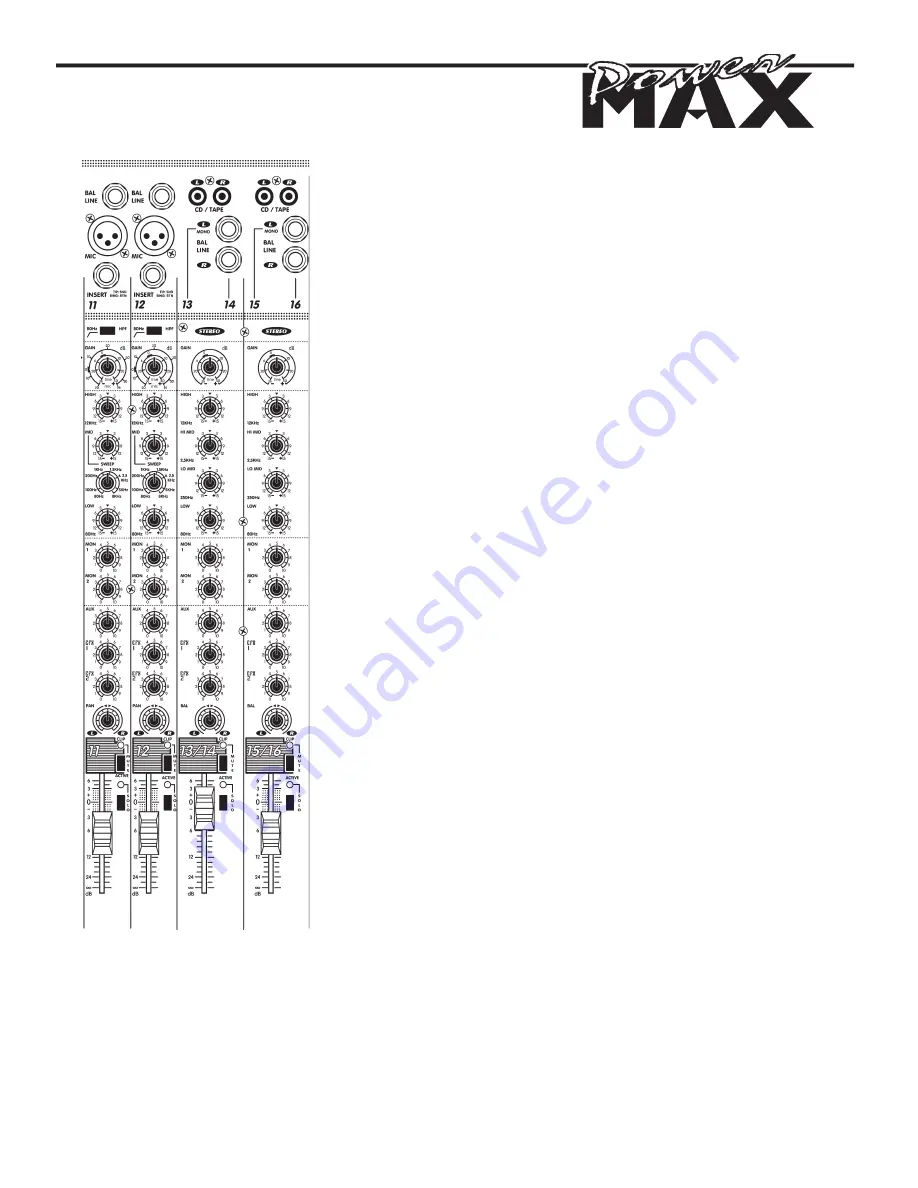
To get started, figure out which channels you want effects on (e.g. vocals, lead guitar, horns
and keyboards - probably not on drums and bass). During a sound check, turn up the
EFX1
send controls on those channels about halfway at first and push up the channel level faders
also about halfway. Next, go to the lower right area of the control panel and set the
EFX MODE
switch to
STEREO
– the
STEREO LED
will illuminate (we are starting out with stereo effects,
you can experiment with the dual
MONO
effects later). Now dial in the desired effect using the
EFX SELECT
and
MODIFY
controls – the menu of presets for
STEREO
operation appears below
the dials. Next, turn up the
EFX1
L&R
(main system)
RETURN LEVELS
master about halfway.
Now push up the
L&R
main master faders to a moderate listening level, as well as th
EFX1
send
master. Finally, re-adjust the channel
EFX1
send levels to add or subtract the effects intensity in
the main mix. Alternatively, you may preview the effects through headphones using the
SOLO
buttons covered later on. To preview the effects on the monitor mixes, plug in headphones (jack
located at very front of mixer, right side below the arm rest) depress the
MON1
and/or
MON2
SOLO
buttons, set the
SOLO
MODE
to
PFL
and turn up the
HEADPHONE
master.
• The channel
EFX1
send controls are exclusively for the internal effects system.
The channel
EFX2
send controls allow you to add external
or
internal effects. With no exter-
nal effects units connected between the
EFX2 SEND
jack and
L/R RETURN
jacks, and with the
master
EFX MODE
button set for
MONO
(choice of 16 presets), the internal EFX2 system will
be available to the mains and monitors. Simply set the
EFX2/MODIFY
dial for the desired effect
according to the menu appearing above that dial, then adjust the
EFX2 SEND
and
RETURN
masters to blend in the effect with the straight signals. Use headphones and the
MON1
and/or
MON2 SOLO
buttons to listen to the effects mix in the monitor system. The
MON
itor
SOLO
works the same with the
AFL
(
A
fter-
F
ader-
L
isten) and the
PFL
(
P
re-
F
ader-
L
isten).
With the
EFX MODE
button set for
STEREO
, the channel
EFX2
send controls will appear not
to function, however they still do.
EFX2
send signal
is
available at the
EFX2 SEND
jack and is
regulated by the
EFX2 SEND
master fader. You may now connect external effects between the
SEND
and
RETURN
jacks, or you may alternately use the
SEND
jack to supply mono recording or
broadcast signals not requiring effects (like the
AUX
signal,
EFX2
is
dry
and
post
-channel fader).
When employing an external effects unit, connect the
EFX SEND
jack to the input of the
unit and the
EFX RETURN
jacks to its outputs. If it is not a stereo effect, connect its out-
put to the
L / MONO EFX2 RETURN
jack only. The effect unit’s output may be previewed
through headphones with the
EFX2 SOLO
button depressed and the
SOLO MODE
button
in
PFL
position.
AFL
gives you
EFX2
to
MAIN RETurn
level
PAN Control (Mono Channels)
This regulates the
post
-fader channel signal routing to the
L&R
main faders. Signal levels are
compensated at the
L&R
rotation extremes so that panning during a performance will result
in minimal
SPL
losses in the
center
-field audience areas.
In a stereo setup, the
PAN
controls would normally be set at or near center so audience
members on both sides can hear everything properly. However if stereo is not an essential part
of your PA sound, you might opt to convert
POWERMAX
to mono operation. To accomplish
this, simply patch the
L / MONO
(left main/mono)
LINE LEVEL OUTPUT
into
both
the
AMP A
and
AMP B AMPLIFIER INPUTS
with a standard “
Y
” cable. Now, both main power amps are
receiving a mono mix. This will enable you to use the
PAN
controls to set up two submaster
groups – for example you could pan all the drum channels left and all the rest right. Now the
L&R
master faders become group masters. These master faders are placed close together, so it is
easy to move them both at once when making main system level changes.
BALance Control (Stereo Channels)
This regulates both the channel output routing to the
L&R
main faders and the comparitive levels
of the stereo signals within the channel. If you have patched for mono operation (see
PAN
control
above) it is possible to connect two different mono
line
-level sources to a stereo channel and use
the
BAL
control to regulate their relative volumes. For more on this, see under
BAL LINE INPUTS
.
CLIP/MUTE Light
The
CLIP LED
is triggered at
-6dB
below the channel’s actual clipping level. When the
MUTE
button
is depressed, the
CLIP
light will come on at half–brightness and will still flicker to indicate clipping
With the
CLIP
light threshold set below actual clipping level, it is possible to allow a certain
amount of light activity without worrying about distortion. As a result, you may use the
CLIP
light to help you adjust the
GAIN
control. See under
GAIN
Control
for more about this.
MUTE Button
MUTE
shuts off the channel and all sends except
PFL
.
MUTE
is a timesaving feature that enables
you to put channels, which you have adjusted during the sound check on
hold
until they are
needed. It is important to do this since every open mic connected to a mixer reduces the sys-
tem’s gain before feedback by several decibels.
Содержание POWERMAX 1622
Страница 1: ...OWNER S MANUAL MANUEL de L UTILISATEUR Y orkville OWNER S MANUAL MODEL TYPE YS1011 ...
Страница 13: ...11 ...
Страница 27: ...25 ...
Страница 32: ...30 ...





















